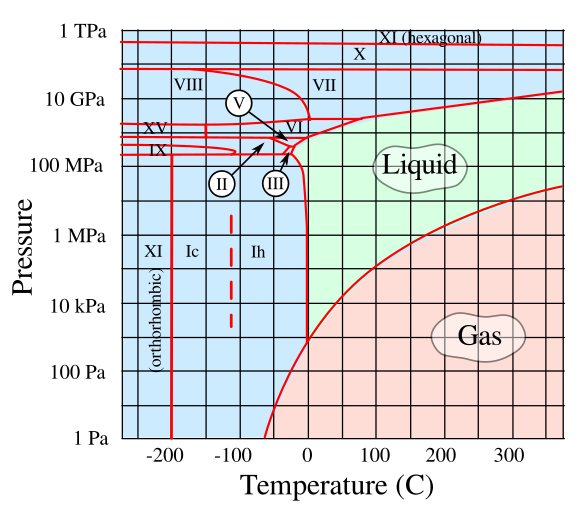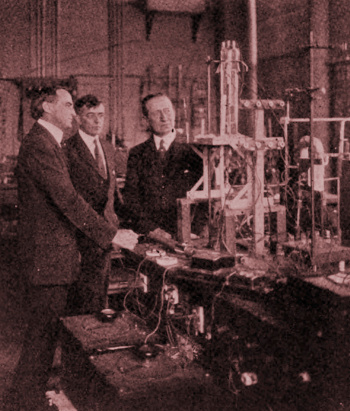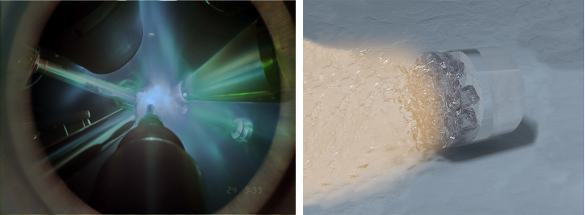Ice XVIII
June 24, 2019
The past few weeks of warm
weather at
Tikalon's home in the
Northeastern United States makes it seem that
winter was just a
bad dream. We can expect much lower home
heating bills; and, also,
safer automobile driving on
roads devoid of
ice and
snow. While winter travel
hazards of snow and heavy ice on road surfaces are easy to see, we're sometimes surprised by
black ice on apparently clear roadways. Black ice is the easily unnoticed thin layer of ice that sometimes forms after a light
rain on road surfaces that are below the
freezing temperature of
water.

A common road sign in the Northeastern United States.
Black ice will form on any road surface during light rain when the temperature of the road surface is below the freezing temperature of water, bridge surfaces will often cool to such temperatures before the rest of the road.
That's because frigid air cools the bridge from both above and below.
(Wikimedia Commons image.)
What is called black ice is not a unique
phase of
ice. It's just the ubiquitous
hexagonal crystalline form of
solid water,
Ice Ih, that we encounter in our
normal environment. Because of its simple
molecular structure and
hydrogen bonding, water is a strange
material, and it's most unusual
properties are noted on many
websites. Its most unusual property is that its solid form is less dense that the
liquid, so ice
floats. This property was very important to the
evolution of life on Earth.
The ice that we know is just one of many of the solid forms of ice; but, since these exist at temperatures and
pressures far beyond
room temperature and
atmospheric pressure, they are found only in the
laboratory. The temperature and pressure conditions for the existence of these many forms of ice can be found in the
phase diagram of water shown below,

Phase diagram of water up to a pressure of 1 TPa (10 Mbar). The solid forms of water, not all of which are shown here, are Ice Ih, the ubiquitous hexagonal crystalline form of ice; ice Ic, a form of ice in which the oxygen atoms are arranged in the diamond cubic structure; ice II, a rhombohedral crystalline form of ice; ice III, a tetragonal crystalline ice that's denser than water; ice IV, a metastable rhombohedral phase of ice; ice V, a monoclinic crystalline phase of ice; ice VI, a tetragonal crystalline phase of ice; ice VII, a cubic phase of ice; ice VIII, a version of ice VII with a more orderly atomic arrangement; ice IX, a tetragonal phase of ice; ice X, a phase of ice that forms at about 70 GPa; ice XI, an orthorhombic crystalline form of ice that's the most stable configuration of ice Ih; ice XII, a tetragonal, metastable, dense crystalline phase of ice that's about 1.3 times denser than water; ice XIII, a monoclinic crystalline phase of ice; ice XIV, an orthorhombic crystalline phase of ice; Ice XV, a phase of ice VI in which the hydrogen nuclei are well ordered; and ice XVI, the ice having the least density. (Rendered using Inkscape from data at Wikimedia Commons by Cmglee. Click for larger image.)
As can be seen from the above phase diagram, there's a solid form of water,
ice IX, that's stable at very low temperatures at pressures between 200 and 400 MPa. This
tetragonal crystal has a density of 1.16
g/cc, which is 26% higher than ordinary ice. While few people are familiar with ice IX, many people are familiar with the
fictional material,
ice-nine, from
Kurt Vonnegut's novel,
Cat's Cradle.
As I wrote in an
earlier article (Fictional Materials, April 21, 2016), Vonnegut's phase of ice has the
dangerous property that it will spontaneously
crystallize water into ice-nine under
normal temperatures and pressures, but it will only
melt at 45.8 degrees
Celsius, slightly above
Earth's ambient temperature. As you can see, this would cause serious problems for Earth's
ecosystem.
Vonnegut said that the ice-nine idea came from
Nobel Chemistry Laureate,
Irving Langmuir of
General Electric's research laboratory. Vonnegut was familiar with Langmuir's work, since he had worked in the
public relations office at GE in
Schenectady, New York. As the story goes, Langmuir suggested the idea of an ice that's solid at room temperature to
H.G. Wells when he visited the laboratory. Since Langmuir and Wells never
published anything about ice-nine, Vonnegut decided to use the idea himself after the
deaths of both Langmuir and Wells. The
character of the ice-nine
inventor, Dr. Felix Hoenikker, is based on Langmuir.

Left to right, Willis R. Whitney, Director of the General Electric research laboratory, Irving Langmuir, and Guglielmo Marconi, August, 1922.
They're looking at a recently developed 20 kilowatt triode vacuum tube.
Both Langmuir and Marconi were Nobel Laureates, Langmuir in chemistry and Marconi in physics.
(Wikimedia Commons image, modified for artistic effect.)
One unique solid phase of water,
ice XVIII, also known as
superionic water, exists at extremely high temperatures and pressures. Ice XVIII consists of oxygen
ions in a
crystal lattice with the hydrogen ions floating freely within the
lattice interstices. This free movement of hydrogen ions is
analogous to the movement of
electrons in a
metal, so superionic water is extremely
conductive. Ice XVIII was
conjectured to exist for many years before high pressure laboratory techniques had advanced to the stage at which it could be
experimentally demonstrated. Interestingly, since it's a conductive material, ice XVIII would actually be black in color, just as conductive
ceramics are black.
Now a team of
scientists and
engineers from
Lawrence Livermore National Laboratory (Livermore, California) and the
University of Rochester (Rochester, New York) have successfully created ice XVIII and verified its creation using
in situ X-ray diffraction.[1-3], many years after its
theoretical prediction in 1988.[4] They used
high-powered lasers to
shock wave compress water to 100-400 GPa and 2,000-3,000 K, creating a
nanosecond instance of this water phase.[1-2] Says LLNL
physicist,
Federica Coppari, a lead
author of the paper, "...compressing water to such pressures and temperatures and simultaneously taking snapshots of the atomic structure was an extremely difficult task, which required an innovative experimental design."[2]
The possibility of the existence of ice XVIII started with the 1988
computer simulations of
Pierfranco Demontis, who was then at the
University of Pennsylvania (Philadelphia, Pennsylvania)).[4] These simulations showed the possibility of superionic ice with a conductivity above 100
siemens/
centimeter, which is almost as high as that of a metal.[1]
The current experiment builds on one conducted last year for which indirect evidence for ice XVIII was obtained.[5] In that experiment, water was first compressed
mechanically to about 2 GPa, using a
diamond anvil cell. The cell, containing
ice VII, was then blasted with a laser to create a conductive ice.[3] The current experiment skipped the mechanical squeeze and laser blasted water contained in a diamond anvil cell. Additional laser beams were used to
vaporize a nearby
iron foil, and this process generated
X-rays for
analysis of the water specimen compressed to 100-400 GPa and heated to 3,000-5,000 degrees
Fahrenheit.[2,3] The
X-ray diffraction pattern confirmed the new
face-centered cubic phase of ice.[1] Says Coppari,
"The x-ray diffraction patterns we measured are an unambiguous signature for dense ice crystals forming during the ultrafast shockwave compression demonstrating that nucleation of solid ice from liquid water is fast enough to be observed in the nanosecond timescale of the experiment."[2]

Creation of ice XVIII. The left image is a photograph of the X-ray diffraction experiment in which high power lasers are focused on the water sample to compress it into the superionic ice XVIII phase. Additional lasers irradiate an iron foil to create the X-rays for analysis. The right image is an artist's impression of the laser compression experiment in which water in a diamond anvil cell is compressed by shock waves and heated to produce the conditions for ice XVIII formation. (Left image created by Marius Millot/Federica Coppari(LLNL) and Eugene Kowaluk (LLE); right image created by Marius Millot, Federica Coppari, Sebastien Hamel, and Liam Krauss. Click for larger image.)
Ice XVIII might be a common phase of water in the
universe, since it might exist within large
planets where pressures and temperatures are within the range for its formation, examples being our
Solar System's own
Uranus and
Neptune.[3] Measurements of the
magnetic fields of these planets have shown complex and uneven structures that might be explained by an interior layer of superionic ice.[2-3,7] Ice XVIII is just another phase of water, but it behaves as if it were a new
state of matter.[3]
References:
- Marius Millot, Federica Coppari, J. Ryan Rygg, Antonio Correa Barrios, Sebastien Hamel, Damian C. Swift, and Jon H. Eggert, "Nanosecond X-ray diffraction of shock-compressed superionic water ice," Nature, vol. 569, no. 7755 (May 8, 2019), pp. 251-255, https://doi.org/10.1038/s41586-019-1114-6.
- Research Reveals Atomic Structure of Superionic Ice, Lawrence Livermore National Laboratory Press Release, May 8, 2019.
- Joshua Sokol, "Black, Hot Ice May Be Nature's Most Common Form of Water," Quanta Magazine, May 8, 2019.
- Pierfranco Demontis, Richard LeSar, and Michael L. Klein, "New High-Pressure Phases of Ice," Physical Review Letters, vol. 60, no. 22 (May 30, 1988) Article no. 2284, https://doi.org/10.1103/PhysRevLett.60.2284.
- Superionic Ice Computer Simulation, YouTube Video by Millot, Coppari, and Kowaluk (LLNL), May 8, 2019.
- Breanna Bishop, "First experimental evidence for superionic ice, Lawrence Livermore National Laboratory Press Release, February 5, 2018.
- Li Zeng and Dimitar Sasselov, "The effect of temperature evolution on the interior structure of H2O-rich planets," The Astrophysical Journal, vol. 784, no. 2 (March 10, 2014); also at arXiv.
Linked Keywords: Weather; Tikalon; Northeastern United States; winter; nightmare; bad dream; central heating; invoice; bill; safety; automobile; driving; road; ice; snow; hazard; black ice; rain; melting point; freezing temperature; water; road sign; rain; temperature; bridge; Wikimedia Commons; phase (matter); hexagonal crystal system; solid; Ice Ih; biophysical environment; molecular structure; hydrogen bond; hydrogen bonding; material; materials properties; website; liquid; buoyancy; float; evolution of life on Earth; pressure; room temperature; atmospheric pressure; laboratory; phase diagram; phase diagram of water; pascal (unit); ; bar (unit); ice Ic; oxygen; atom; diamond cubic structure; ice II; trigonal crystal system; rhombohedral crystal; ice III; tetragonal crystal system; density; dense; ice IV; metastability; metastable; ice V; monoclinic crystal system; ice VI; ice VII; ice VIII; ice IX; ice X; ice XI; orthorhombic crystal system; ice XII; ice XIII; monoclinic crystal system; ice XIV; Ice XV; hydrogen; atomic nucleus; ice XVI; Inkscape; data; Cmglee; ice IX; tetragonal crystal system; tetragonal crystal; kilogram per cubic meter; g/cc; fictional material; ice-nine; Kurt Vonnegut; Cat's Cradle; hazard; dangerous; crystallization; crystallize; standard conditions for temperature and pressure; normal temperatures and pressures; melting point; melt; Celsius; Earth; ambient temperature; ecosystem; Nobel Prize in Chemistry; Nobel Chemistry Laureate; Irving Langmuir; General Electric; research; laboratory; public relations; Schenectady, New York; H.G. Wells; literature; publish; death; character (arts); invention; inventor; Willis R. Whitney; Guglielmo Marconi; kilowatt; triode; vacuum tube; ice XVIII; superionic water; ion; crystal structure; crystal lattice; interstitial compound; lattice interstices; analogy; analogous; electron; metal; electrical conductor; conductive; conjecture; experiment; experimentally; ceramic; scientist; engineer; Lawrence Livermore National Laboratory (Livermore, California); University of Rochester (Rochester, New York); X-ray crystallography; X-ray diffraction; theory; theoretical; power (physics); high-power; laser; shock wave; physical compression; compress; nanosecond; physicist; Federica Coppari; author; computer simulation; Pierfranco Demontis; University of Pennsylvania (Philadelphia, Pennsylvania); siemens (unit); centimeter; mechanic; mechanical; diamond anvil cell; vaporization; vaporize; iron; foil; X-ray; X-ray crystallographic analysis; Fahrenheit; X-ray diffraction; cubic crystal system; face-centered cubic; nucleation; photograph; focus (optics); electromagnetic radiation; irradiate; artist; heat; heated; universe; planet; Solar System; Uranus; Neptune; magnetic field; state of matter.